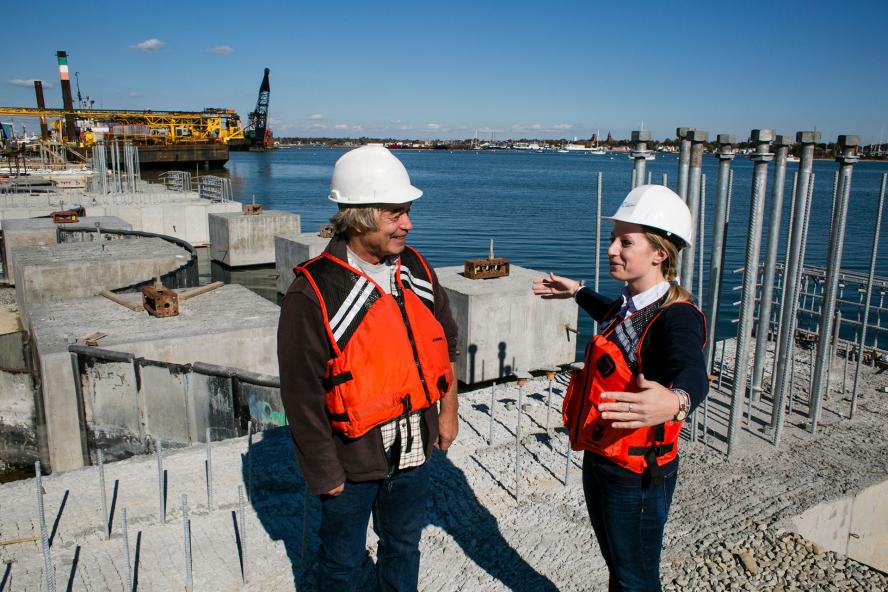
From the archives: August 25, 2014
A first-in-the-nation $100 million port being built near Cape Cod is showcasing Tufts talent. Half the engineers managing the development of the port, which will boost offshore wind projects in Massachusetts, are Jumbos. But most had never met before.
The New Bedford Marine Commerce Terminal is being designed to support the construction, assembly, and deployment of offshore wind projects. The port must be able to bear wind power components that weigh as much as 500 tons, a colossal feat of engineering. "The parts are extremely heavy—ten times heavier than the maximum payloads for the huge container cranes you see along the Boston or New Jersey shoreline," says Eric Hines, a Tufts engineering professor of practice and head technical consultant on the project.
A common thread
Hines and project manager Christen Anton, E12, work for the owner of the project, the Massachusetts Clean Energy Center (CEC), an agency managed by the Massachusetts Executive Office of Energy and Environmental Affairs and funded by rate-payer utility surcharges. The project is funded by the CEC and the state.
Jumbos joining Hines and Anton are estimator and construction advisor Allen Waller, E74; geotechnical project manager Diane Baxter, E90; and civil engineer John McAllister, E03, all consultants working for Apex Engineering, the lead design team hired by the CEC.
Anton was a student of Hines'. None of the other engineers had ever met before.
"We graduated decades apart, but there's a common thread,” says McAllister. "We each have very different areas of expertise, but share the methodological mindset, critical thinking, and ability to problem solve that’s necessary to succeed in a project like this. Tufts taught us that."
Adds Baxter, "Coming from Tufts, you're capable of doing anything you want to. Our little group illustrates that there are so many opportunities and career paths you can take."
As Hines' student and capstone advisee, Anton worked on the terminal project as an undergraduate. "Eric ran his own capstone project around the terminal," she says. He also brought in other engineers from the project to mentor his students and support them through the semester as they attempted to design the structural bulkhead of the terminal. "To our best extent as students, we tackled the most challenging part of the design."
Ready and raring to go
Having hands-on experience prior to graduation was invaluable for Anton. "Thanks to Eric and my other professors who were really invested in us students, I wasn't only prepared, I had a huge headstart on an actual project," she says.
As renewable energy projects get off the ground, Hines sees Tufts graduates playing a central role in their design. "Sustainability is one of the major focuses of the engineering school, and students are being prepared to be work on the cutting edge of global issues," he says.

Renewed energy
While these five Jumbos will wrap up their work on the project by the end of the year, the impact may be felt for decades. The hope is that the terminal will create a significant new industry in New Bedford. After suffering a decline like so many other port cities, New Bedford has been making a comeback in the past few years, and residents are excited about the additional boon anticipated by the opening of the terminal. "I live just across the river and it’s one of the biggest things going on in the area," says McAllister. "People corner me at parties to pepper me with questions about how the project is coming along. It's cool to be a part of that."
